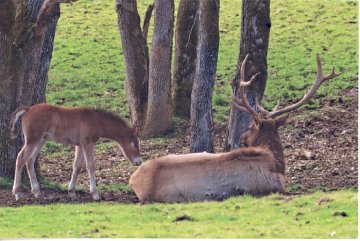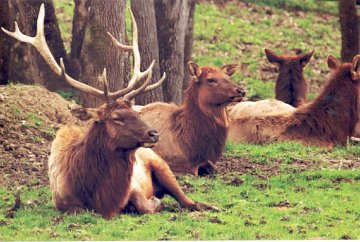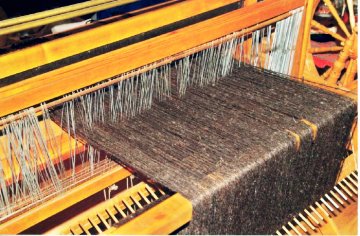~~* Black Sheep Newsletter............Issue 135............Spring 2008 *~~
 †
†
THE HOMESTEAD: Southern Cascade Geography, a Hard Winter
Clover blooms, kids cavort
Lambs all fuzzy join the sport
All of nature's babies play
...the sun shines brightly – it is May!![]()
I take my shepherd's staff in hand
and walk beside this hairy band
Winter's glum is far away
...the sun shines brightly, it is May!![]()
The tenth spring kid has just been born
(I fed his mom some extra corn!)
Rain clouds with bright light do play
Of course! It is the month of May![]()
Geography Lesson, Southern Oregon Cascades
Ann Snyder gave us a small geography lesson in the last issue pertaining to the great Northwest, and she explained where her ranch, White Diamond, was situated, how much rainfall they could usually expect in a year's time (my goodness, that's desert country!) and gave us a few other particulars.![]()

Big Tom showing his stuff
So, I decided to share with readers a bit more about our own ranch, one we've named Singing Falls after local Native American tradition. We are at the southern tip of the Cascades, at the same time situated at the northern end of the Klamath ecological zone. We are 60 miles from California's northern border and 80 miles away from the Oregon Pacific coast. As the crow flies we are about twenty miles west of Mount Mozama (Crater Lake) and the High Cascades..![]()
That means we do get a larger amount of rainfall than they do where Ann lives – 40 inches per year is a good estimate. Singing Falls is nestled at about the 1400 foot level. Jagged toothed mountain peaks surround us entirely. Our home is nestled in a valley that once was the year-round home to a thriving village of 3,000 Native American Indians, the Cow Creek Band of the Umpqua. This land was capable of sustaining the tribe until the Europeans came out in their wagons and things changed drastically. The streams ran full of Coho, Chinook and Chum Salmon along with huge 'sea run' Cutthroat and Steelhead trout. It was and is a rich land, its history vast.![]()
Our home is situated at one of the headwaters regions of what is known as the Umpqua Basin Watershed. The creek that crosses our homestead is now seasonal, though we'd like to see it restored to its former glory as a year-round perennial stream. We are currently in the throes of a massive "aquatic habitat restoration project" and the stream getting all the attention is called Joe Hall Creek. Joe Hall crosses our property on the diagonal and then flows into the larger tributary called Elk Creek. Elk Creek then joins the main stem, the South Umpqua River. The South Umpqua and North Umpqua converge sixty miles away just outside of the city of Roseburg.![]()
Salmon swim 260 miles from the ocean to finally arrive at their destination (our own homestead body of water, Joe Hall Creek) and since their return in 2004 after a 40-50 year hiatus, we've been busy with stream restoration work. Even as I write this column, my spouse is out there at the water's edge planting baby sugar pine trees and thinning overgrowth along the riparian zone.![]()

A young colt with a bull elk
If we let it all go the way it's gone over the past couple of centuries, there won't be any salmon for future generations. Stan and I figure that we can play a part in the 'big picture' of making sure Oregon remains wild and scenic. We feel a deep sense of responsibility to take on this task as stewards of land that interfaces with wilderness. Stan has coined the phrase, "We are left to cultivate wilderness" to express our strange doings to many of our neighbors.![]()
Elk and salmon, wild turkeys and eagles, bear and cougar all make their home in Tiller, Oregon.. It's wild country, to be sure. We are surrounded by Umpqua National Forest and private timberland. An old growth forest butts our land on two sides with centuries-old conifer trees that tower into Oregon skies. The pristine forest stands tall and unhindered, so far untouched by whining chainsaws.![]()
This morning I looked out our kitchen window as the small flock of wild turkeys that has laid claim to our land came sauntering up the driveway. The big tom was in control of his harem and would not let them out of his sight. Periodically he strutted in front of his ladies, fanned his tail feathers, did a jig and then let out a hearty 'gobble-gobble' to let them know that he was in control of the situation.![]()

Bull with harem
Elk Creek was appropriately named so long ago. The Tiller elk herd calve in the wilderness adjacent to our back forty and are causing their usual winter/spring traffic snarl-ups. They stand in the middle of the highway while chewing their cud, oblivious to any and all motor vehicles. When we drive to Canyonville 32 miles to the east where we purchase groceries and fuel, we are careful when we approach the bend. Stan had to brake hard a couple of times recently and wait for the elk to slowly make their way across, and that only after he shouted out the window – let's get a move on it!![]()
We are seeing yet again that same pair of Canadian geese who rendezvous each year in my neighbor's hay field. They are a mated pair (these geese mate for life) and spend a great deal of time telling one another how much they love each other while they stand there in the green hay field bill to bill.![]()
Whenever we go into the bigger cities (which is not often) we are nearly dumbfounded by all the traffic and the budding housing developments that seem to pop out of the ground like daffodils. We can't wait to get home after doing our important shopping. Living out here, we sometimes feel we are stuck in a time warp belonging more to an earlier century. I don't even know if the town of Drew (the once thriving center of our village) is on the maps.![]()
A Hard Winter
It was a hard winter. I am a goatherd in every way (versus "shepherd" - keeper of sheep) for I keep goats. The part I hated most about this past winter was losing three of our best colored angora goats in rapid-fire succession. The first loss occurred on Thanksgiving Day while we visited away from the farm. I've heard other shepherds speak of the fact that Murphy's Law comes into full effect when one must leave the farm. Count on it, the shepherds swear an oath – that's the day nature will go ballistic. Your sheep will break out of their pens, your dog will bite a neighbor or run away, a tree will fall on your fence. You'll lose your best animal to a predator, disease or fly strike.![]()
Like Whitefish Bay Farm's sheep, (see Dick Regnery's dissertation regarding "Disrupting the Routine") our goats adhere to a strict set of rules (their own rules, mind you) and keep a rigid schedule. If we abide by their rules, we are safe. If we deviate, they become (often enough) deviant.![]()
We, as goatherds, dare not stray from the norm. Cows love routine. Livestock guardian dogs and other breeds of dogs set their clocks by the time of day you get up, make your coffee, do your chores or feed them. So it is with the angora goats. Break the pattern and you are a goner.![]()
So, when Thanksgiving Day rolled around and we decided to take a day off from the farm (after feeding and watering everyone, changing clothes into respectable and clean garb, picking out the hay from my hair and out of Stan's beard so that we would look presentable to folks in town), we thought all would be well. We crossed our fingers and hoped so anyway.![]()
Indeed, such was not the case. We came home to the loss of a prime young animal that Thanksgiving day. He was a young black buck that was going to serve as a future herd sire. New blood in the herd from another farm, irreplaceable lineage, he was a beautiful buck. Since he was not born on this farm and had no mother here, he was never really accepted by our does. Like black widow spiders, they pounced on and did away with their future mate.![]()
Spring Is Really Here!
It was 65 degrees yesterday and the sun shone brilliant in the sky. Winter's chill is behind us, along with the sorrows the cold months brought our way. The first colored angora goat kid was born a week ago and another (this time a doe) was born an hour ago. The rest will follow in quick succession according to our calendar.![]()
Now that spring has come boisterously and wonderfully along, she promises abundant green pasture grasses, flowers and garden produce. We are already planting peas in the raised bed garden – I can't wait for Chinese stir fry using all of our own homegrown vegetables.![]()

Black Mohair on the loom
I've sleyed the antique loom with hand spun black mohair. A woman's shawl, I'll be weaving a border on both ends in an overshot pattern called Flame Point. The pattern will be woven with dyed red mohair. The rest of the piece, purely black, will be woven in plain weave.![]()
Though I've been successful in the past weaving overshot with handspun mohair, I've never attempted this particular overshot pattern before. I find myself feeling a bit intimidated and I keep finding 'other things' to do around the farm. I need to get busy weaving, I know, but don't want to have to take out the whole warp and begin again because I worked so hard getting it there in the first place.![]()
There are times I've wanted to go further with my weaving skills. If there is a weaving guild in Roseburg, I think I might have to look it up. I need 'hands on' practice. I need a teacher standing there next to me explaining things. Books have taught me a lot and I've been mostly a self-learner. Now, I feel, I need a real human being to teach me more.![]()
THIS IS THE ONLY PICTURE I WILL SEND BY E MAIL – A PICTURE OF THE BLACK MOHAIR ON THE LOOM -
It's sputtering rain today and cold. Even though winter's chill is gone, early spring can throw her tantrums. She's throwing one today. Brrrrrr. That mohair shawl would sure be nice to snuggle into. Better get busy and at least start to throw those shuttles filled with mohair...![]()
Alexandra Scribe
Homestead Home
TOP






